#dmc is a very personal story it has general reflections on humanity but these are always in support of that core personal conflict
Explore tagged Tumblr posts
Text
Actually yeah it is really interesting the way DMC uses its relatively repetitive plot cause like despite literally every game having the basic premise of "demon attack some guy is doing crazy shit" none of that really ever, matters. It's always set dressing for what Devil May Cry stories really are about and that is extremely personal conflict within families, especially the Sparda family. In 1 Dante get's brought to Mallet Island cause Mundus is trying to unite the demon world and the human world but like, does any of this really matter? No not really, it's just an excuse to get Dante there. Mundus isn't an antagonist/villain to face because he's ending the world, it's because he's the one responsible for destroying Dante's family. This keeps true for the rest of the franchise and it's also why the antagonists* themselves aren't necessarily that deep, because their desires to rule the human world are just stepping stones for the central familial conflicts/narratives the story explores. The asterisk there is obvious, it isn't a coincidence that Vergil, who can be considered the overarching antagonist of the franchise and clearly its best, is the antagonist directly tied to that familial conflict.
#its also why the games really do not care about civilian casualties#cause like the demon attacks themselves dont matter theyre just a way to get everybody in one place and focused on one thing#dmc is a very personal story it has general reflections on humanity but these are always in support of that core personal conflict#like its not really a trigun i would say where the personal conflict between vash and knives is there to support the wider points about lif#thats what makes the reboot super interesting in comparison lol cause that was REALLY trying to say something#but not only was it horribly handled but it also sacrificed that personal conflict to do that dante is just right and vergil is just wrong#dmc
10 notes
·
View notes
Text
Not to keep on with this but right so I made a post about Vergil and Bernini and in that post I mentioned what art works and pieces I think represent the other parts of the DmC trio, Kat and Dante. And I just wanted to follow up on that with more focused posts because yall have no idea, I’m very into this whole thing.
First up: Dante
So Dante I go into a good deal in the Baroque essay already so some of this is a rehashing but I just wanted to go more in depth about Dante and Caravaggio’s Davids.

(David and Goliath, 1599)
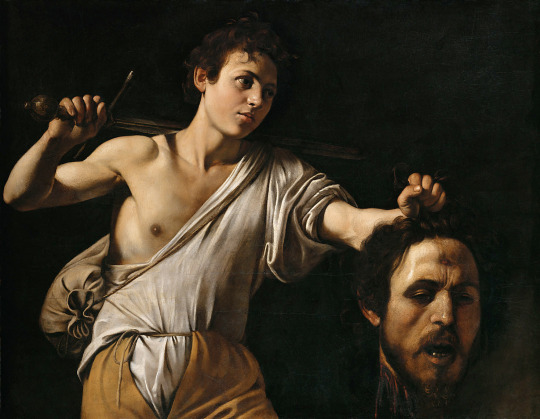
(David with the Head of Goliath, 1607)
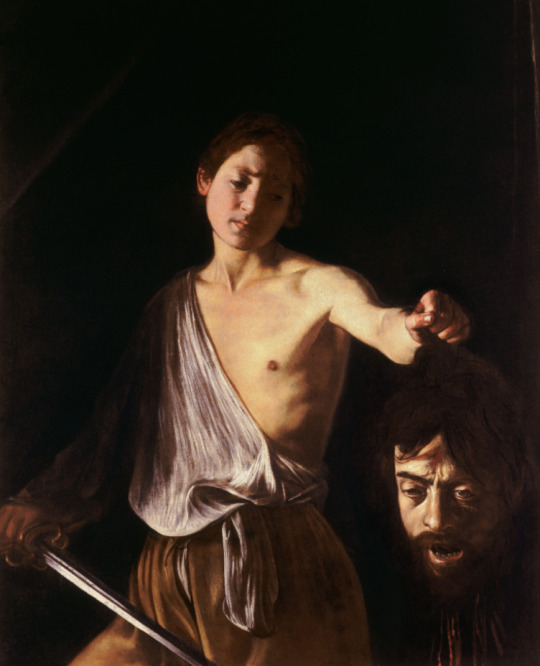
(David with the Head of Goliath, 1610)
More about Dante, Caravaggio, and especially that last David under the cut! This one got a little long.
Ok so first things first, like discussed in the Baroque essay, Dante is Baroque and the game is based around Caravaggio’s Baroque to a point where many of his paintings are directly referenced. That last David in particular is referenced directly in the game. See below:
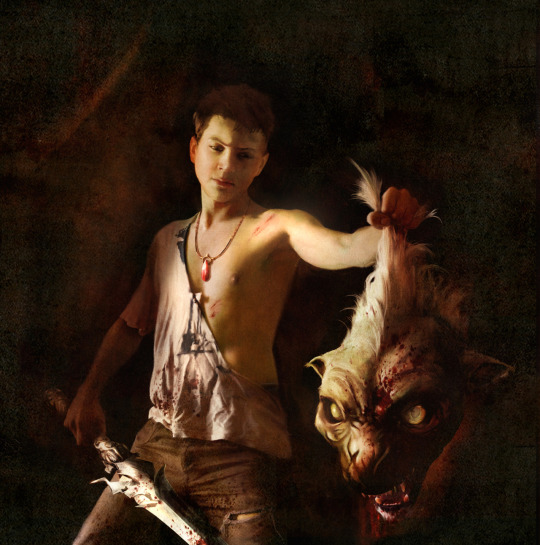
so I’m not really saying anything the game hasn’t really done itself here. Dante is the main character, he is represented by Baroque and Caravaggio. That’s his vibe, that’s the parallel. And it’s a very intentional one I mean in Talexi’s art book he discusses picking Caravaggio as an influence and the overlap between Dante’s whole deal and Caravaggio’s own. But I’m like really into Caravaggio’s David’s and want to talk about that and the neat way this plays with Dante’s whole deal so, let’s do it.
To quickly summarize Caravaggio and the background of his last David: Caravaggio was an angry guy who worked in Rome during the Baroque period until he killed a guy for Reasons (probably a bet, possibly a woman, possibly a tennis match or something, probably the bet). He gets kicked out of Rome, does some stuff (joins a knighthood? at some point then leaves the knighthood?), gets word that the pope wants to pardon him. He goes back to Rome with some art but dies on the way at the ripe age of 38. One of the paintings with him that makes it on this trip is the last David.
What I like about Caravaggio’s David’s is how different they are then other David’s that come up in the art history canon. Just for comparison I’ll share the famous David but also Bernini’s David from the same time period.
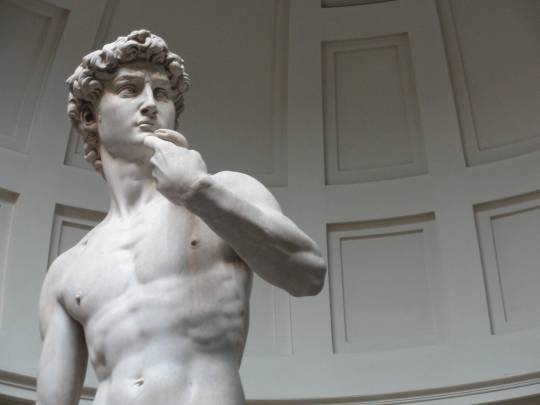
(The David, Michelangelo)
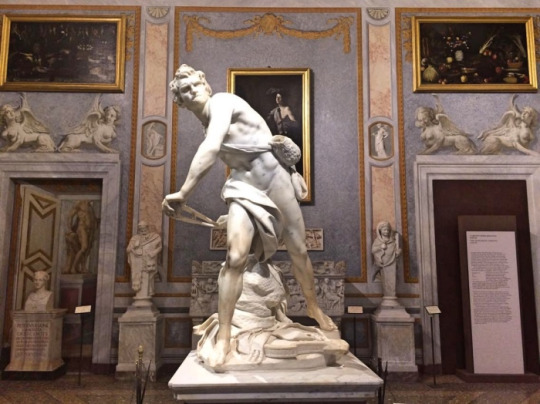
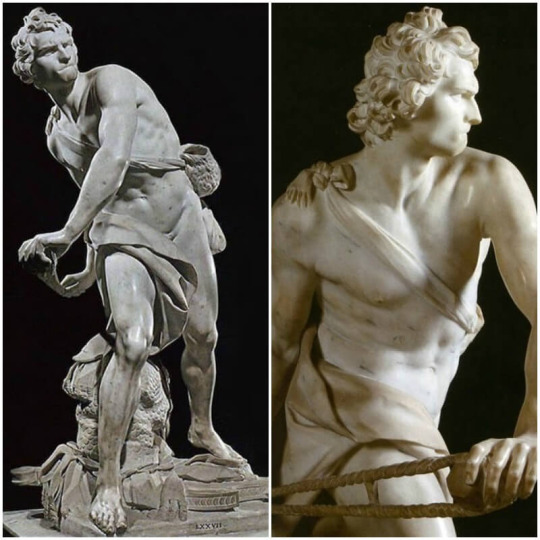
(David, Benini. Pain to get a photo of s2g)
The first key difference is I mean, all three of Caravaggio’s David’s are wearing clothes which I think is neat in that I imagine he would be wearing those given the situation. But beyond that, what strikes me about Caravaggio’s David’s is their youth. In the biblical story, David is more the age Caravaggio consistently depicts him at. Which is about approximately preteen or teenage. The second thing that strikes me is the confidence and power displayed in Bernini and Michelangelo’s David’s evoke. But Caravaggio’s are not confident, not the way these one’s are. And especially that last one.
Caravaggio’s David is unsure. He’s just done this thing, killed this man, but he doesn’t seem to have quite processed it in the first two. But in the third, he is processing it. And he’s not processing it well. This is a David who is unsure. This is a David who seems to pity the man who’s head he now holds by the hair. This is a David who is not strong and unwavering and confident and elegant, this is a child who just killed a man. This echo’s in the games interpretation of the scene, that same worry echoing in Dante’s brow that’s in Caravaggio’s. It’s a sympathetic David in that he seems to be unsure if this choice was worth the personal toll but also in the sense that the viewer is sympathetic to him, they feel bad for this child who has just been forced to make this choice.
Reboot Dante’s life is not one about choice, it’s not really something he seems to be able to do often. Sparda put him into the orphanage and the orphanage put Dante into the foster care system. And ever since then Dante has had to fight. Not by choice, but by necessity. It show’s in his combat style, in his clearly untrained movements focused on power and strength rather then tactics. Vergil, if you watch him fight, he’s much more elegant, his style reflecting practice and technique. Dante, though, throws everything into his movements to kill as fast as possible. That if he just swings hard enough, this’ll all be over faster. He even stumbles in his combat because he’s put so much power into his swings, it’s my favorite little detail.
In the game, it’s mentioned that Dante’s first recorded demon kill was when he was eight years old. It was one of the ‘caretakers’ at the facility he was in. I often wonder if that’s the moment that they were trying to depict in this image, the moment after that. I'm not really sold that he looks eight here but I mean you be the judge of that but bare with me. It’s the mood, that moment right after he’s been forced to enter his new reality for the first time. That he is going to have to fight like this the rest of his life. That bewilderment and regret and just general disbelief that he’s done this, that he’s just killed something. That sorrow for the Dante he was before, like that sorrow that David must be feeling for who he was before as well.
But there’s a second layer here I haven’t gotten to yet. And that’s how Caravaggio’s David is also thought to be a self portrait. No, he’s not David. Caravaggio has painted himself as Goliath. A portrait of Caravaggio for reference:

(Caravaggio as depicted by Ottavio Leoni in 1621)
Usually this is read as a tongue and cheek thing to the pope, like Caravaggio is offering himself in the ultimate repentance for his crimes. He’s sorry, here’s his head on a platter. But there’s something about it being a self portrait coupled with David’s pity for this Goliath that feels kinda...sad in a way.
Further context to this is Caravaggio, on the run or not, did not have a studio. He was a solo artist, which is a bit odd for the period at his level. He did not take students, so his techniques died with him. No one else worked on his paintings, they’re all by his hand. This in particular David was not commissioned either, it was done as a gift. So this was a deliberate thing entirely thought through by him, painting himself as Golith, painting David so full of pity and grief.
It’s sort of this idea of pity for the monster when you yourself are the monster as well as a sort of self hatred. Which reboot Dante is familiar with. Either Dante, preboot or reboot, kind of has this arc about trying to cope with being half demon while hating being half demon. It’s not a part of himself that he likes. The reboot goes further with this though because he doesn’t even have the solace of being half human, he’s also half angel. Reboot Dante goes from seeing himself as a human being to being told no, your not, your the things that you hate and it’s your job to protect people anyway. You are both the out of control monster and a threat, but also their protector.
In either reboot or preboot this isn’t like the most explicit character beat, though it does come up. In the reboot we see it peak through in moments like Dante’s interactions with Phineas. The ‘my father was a demon and I’m nothing like him’ mentality. The reboot makes this more pressing to in that like, the reboot makes it clear that demons are not a hive mind. While they seem to vary in intelligence and free will and all that, the game does not imply that Phineas and Sparda are alone in their grievances where as the preboot paints demons like Sparda and Trish as complete oddities. But part of either Dante’s rejection of Sparda is always rooted in ‘Sparda is a demon, and I’m nothing like the demons.’
This is interesting in the reboot because, unlike Vergil, reboot Dante is always visually contrasted with demon imagery. His world is very red. His color is red. The colors on him, even the blacks and grays, are warm tones. His devil trigger is designed in such a way that the abundance of reds in it are even more prominent then his initial design. The only time he’s not is the scene with the graffiti where he’s positioned on the side with the angels. But visually it’s still made clear. Dante is the demonic twin, Vergil more angelic. On top of that, characters in the reboot love to point out how Dante reminds them of Sparda. Phineas does it and Mundus really does it (the ‘just like your father, too big for your fucking boots’ line). Which further puts Dante at odds with his identity. As much as he thinks he is nothing like Sparda, he’s his fathers son. He’s the demon half of this twin relationship.
I think to like Caravaggio’s David’s just...they don’t want to do this. They’re just kids. They don’t want to kill their Goliaths. But they have to. Which is the spot we see reboot Dante in. He doesn’t want to save the world. He doesn’t want to fight for his life as often as he does. He doesn’t want this. But he has to do it. He might say he doesn’t give a shit, but what’s his choice? When has he ever had a choice? He’s the unwilling savior.
This runs through the game to. Dante doesn’t really want to be here. He makes that clear a lot. And his bravado is constantly a cover to keep him from being too vulnerable, too exposed. But it’s that last fight with Vergil where it all falls apart. He did this because Vergil asked him to, and Vergil didn’t even tell him the truth. And just like everything else, Dante doesn’t want to kill Vergil. He doesn’t want to fight him. But he’s provoked him anyway and got himself in this fight and he can’t let Vergil take the throne. David can’t just let Goliath go.
It’s the end of the game where we finally have Dante completely free of his walls and completely bare and entirely unaware of who he is and what he’s supposed to do next. It’s the same sort of vulnerability that I feel is abundant in that last David. Who is he now after all of this? Does he like this person? What’s he to do now that he knows what he’s capable of, knows what he’s done?
What makes him any different then this head in his hands?
#dmc devil may cry#dmc reboot#devil may cry reboot#dmc reboot dante#devil may cry reboot dante#reboot dante#fab talks meta
104 notes
·
View notes
Text
DMC Tangent #3

Sparda’s Heart
One of DMC’s admittedly cheesy plot threads is the concept of Sparda having a heart. The thing villains “lack” as said in DMC4. The nature of it is kinda ambiguous since it’s broad. Romantic love, compassion in general, the capacity is a core theme of Sparda. The reason he turned on Mundus.
But sadly Sparda has yet to show up as himself in the story. He’s always referenced, a costume for Dante or we’ll see someone take on his demon form using the sword but he’s never been in scene as himself. We’ll never quite know how he functioned emotionally.

However we do get references to Sparda. Many demons, usually ones that met him, will compare him to Dante or Nero. It’s from this that we get glimpses of Sparda’s nature but what I find most interesting is how each son of Sparda carries a trait.
Dante is often compared to Sparda. In his youngest incarnation, DMC3, several demons see Dante’s cocky and rebellious nature as akin to Sparda. Of course Dante’s key trait can be tied to rebellion, thus the name of his sword itself.
Then you have Vergil. We dont get as much with Vergil but we know he idolizes Sparda, his power. In contrast to Dante, Vergil is very cold, quiet and precise. At first you could argue this is him trying to stand out from Dante but given Vergil’s view of Sparda you could argue this was also an aspect of the demon. A powerful but cold and precise approach to his enemies and situation.

It’s too the point you could argue that a good portion of how Vergil acts later is from emulating Sparda. Dante even points to Vergil that no matter how much power he gains he won’t be like their father. He can’t be Sparda, he’s Vergil.
There’s more to Vergil I could rant but that’s for another time. The point is that we can infer from Vergil that precision and a degree of coldness was a part of Sparda.
Of them all, I’d argue Nero may be the closest to Sparda in nature....let me explain before ya rage!

Regardless of how you view his actual proximity to Sparda in lineage, he’s by far the most emotional. He has that cockiness Dante displays and even Vergil can show but the defining aspect is his emotional state in general. Unlike Dante or Vergil, Nero shows a wider array of emotion. (at least more openly)
Vergil is subtle and we’ve seen Dante cry but Nero can go from a flying rage to tears quickly. Yes, it’s usually in relation to Kyrie but what’s important is he does this. Not only is he emotional, he’s openly so.
Beriel makes note that Nero is “just like he was” in allusion not Sparda. Now I’m not gonna argue that one passing statement means Nero is just like Sparda to a tee. Dante and Vergil’s personalities are a contrary to that.

What’s important about that to me is that despite everything Sparda cared about people. As Nero put it “he had a heart that could love another person” which Nero reflects. Nero’s capacity to care, emotional state and growth in power is tied to Kyrie and Credo. A human family.
He loves Kyrie, trope as hell yes, but he also respects Credo. We’ll never know Sparda’s initial reason but his act of rebellion was driven by emotion. He cared about something or someone enough to turn on Hell.
Unlike Dante or Vergil who have an aspect of Sparda, Nero reflects him most. Dante and Vergil can care, and do, but is driven entirely by his emotions.....I’ve rambled haven’t I? I apologize.
You see, I focused so much on the sons of sparda because we never see Sparda in person. We only know what others say or that his sons will reflect aspects of him. Dante and Vergil are like the two halves of his personality. Rebellious and cocky but also cold and precise. Even their red and blue color schemes can be mixed to make the trademark purple Sparda wears.
It’s through them that we can piece together Sparda to a flawed degree. What it paints is the image of a very human demonic entity. Ruled by emotion, cocky from his power, any arrogance tempered by cold precision.
Dante was right, there’s a great deal of confusion surrounding him. Probably a confusion that only Dante himself would know the truth of at this point.
Thanks for reading my rambling. Feel free to add ^__^
=======
Edit: Pls remember this was made prior to DMC5 in which Nero’s status as Vergil’s son was bluntly stated.
17 notes
·
View notes
Text
Devil May Cry 2 Reflections

Now here’s a head-scratcher. How does a sequel to a very strong IP debut, helmed by a creator with an incredible pedigree, turn out to be one of the worst games ever developed by the developer in question?
I’ve heard fragments of an explanation—that the first and second Devils May Cry were developed (at least partially) concurrently, and with insufficient communication between the two teams; that Hideaki Itsuno was only pulled onto the project very late in its development cycle, after it was already clear it was a steamer. I’m sure there is a good reason, but looking at the series as a whole, or even Capcom’s internally-developed library at large, Devil May Cry 2 stands out as an anomaly. I can think of no other internally-developed, numbered installment in a Capcom series that has deviated so abruptly or presented such a nosedive in quality. I mean JESUS. Even Plasma Sword was pretty cool, if ya ask me.
Here are some things that Devil May Cry 2 did worse than its predecessor, Devil May Cry.

The combat. Controlling Dante feels like trying to throw feathers at a bullseye. Slashing your sword through an enemy feels about as meaty and satisfying as batting at a balloon with a flyswatter. Shooting feels like firing loud blanks out of two unwieldy prop guns. The combat often feels laborious; there are too many situations where the only viable approach is to boringly fire off seven-hundred rounds from your pistols while repeatedly jumping into and falling out of range like an adorable red panda trying to reach a human door knob. Some of the enemies have absurd amounts of health but present no evolving threat. The Infested Tanks, for example, mostly just sit there pivoting their enormous cannons slowly and firing at the wall behind you while you slash away at them for actual multiple minutes, your sword swooshing through them like a firm L.L. Bean catalog through thin air. Watch your style rank climb as you flail an ornate metal rectangle mindlessly at a brown public domain asset. Smokin’ Slick Style!

↑ Don't worry.
Speaking of which:
Style ranking. This didn’t really get sorted out until DMC3, but here it seems deliberately configured to discourage improvisation. It seems that only certain moves are deemed stylish enough to even initiate a combo, let alone sustain one, and these are left for the player to guess. So you could be dishing out a lot of damage to a lot of devils before you ever see your first “Don’t Worry,” which by the way, “Don’t Worry”? Tall order, Devil May Cry 2. Tall order.
If you’re good, eventually you’ll claw your way up to “Are You Ready?” Let me assure you that the answer is “No.” Nothing could have prepared us for the banality of Devil May Cry 2, least of all the dazzling, timeless bliss of Devil May Cry.

Dante. I don’t know where they took the real Dante, but he sure as hell doesn’t appear in Devil May Cry 2, unless maybe that’s him disguised as Trish. Trish moves almost identically to the Dante who charmed us in the first Devil May Cry, while this new “Dante” is entirely different and worse. He also has a different voice actor, who has all the personality of a cutting board. I’d take the voice-cracking, LiIGht-hearted delivery of DMC1’s VA over this smoldering gym sock any day. It’s as if they were deliberately trying to illustrate that this Dante is a fraud. Even his looks are an unnecessary departure from the well-liked thing they’d just established. We’re given a whole new Dante model that’s weirdly smooth and blank. He’s like a celebrity lookalike you pay by the hour to make your lame party seem more interesting. Except, as with a celebrity lookalike, it doesn’t work.

Story. No Devil May Cry game has a great story, but 1 and 3 at least have catchy premises. I played all the way through DMC2 and I don’t know what it’s about. I don’t care.
Character progression. I guess there’s an argument to make for giving players the entire suite of moves from the outset—it’s more in line with fighting games, which formed the bulk of Director Itsuno’s resumé at the time—but I don’t remember anyone criticizing the original DMC for continually providing meaningful incentive and evolving the combat through purchasable moves. In DMC2 you still get orbs, but you only really use them to upgrade your weapons’ damage output, so your only incentive for earning lots of orbs is the prospect of ending each boring fight sequence more quickly.

Devil Arms. I don’t think they even call them that in 2, but basically Dante has one melee weapon, disguised as several. The swords you find over the course of the game all function identically, with only nebulous differences in attack power and range. I appreciate that they tried to get you thinking about using different swords for different encounters, but the differences are so slight that it’s hardly worth the trouble of fiddling through menus.
Guns. There’s a special pleasure to be found in a game that lets you attack as fast as your finger can push a button. Capcom built an entire series out of that idea in Strider. Ebony & Ivory offered that pleasure in the first Devil May Cry, bolstered by the satisfying spurts of blood which accompanied each shot. In DMC2 your pistols lack this responsiveness and can only fire at a fraction of the speed. You can also just hold the button down, which makes the player feel considerably less connected to the weapon (pistols don't auto-fire), and firing while moving produces echoey two-shot bursts with a strange syncopated rhythm like a limping horse in a mineshaft.


↑ There is a significant drop in Dante's rate of fire between 1 and 2.
I appreciate that the game gives you so many guns, but no one of them is interesting. They also no longer have distinct Devil Trigger properties, since shooting with DT activated now causes Dante to unleash this game’s bastardized version of Air Raid, wherein his hands turn into lightning uzis. (The lightning hand-uzis are kind of cool, but at what cost?!)
Environments. More disjointed, more linear, less awe-inspiring, and just about as drab as possible, with few exceptions.
All in all, DMC2 is as my friend (who likes this game) often remarks: “The bad-supermarket-toy version of Devil May Cry.” (He likes bad supermarket toys.)
All that said, this is the first time I’ve really given the game a fair chance, and I will give it credit for introducing some good ideas to the series. It also has a way of sneaking up on you with some very visually striking moments amid all the brown, brown…brown.

↑ Welcome to Brown Town.

↑ Better.
Here are some GOOD things about DMC2:
It introduced real-time gun-switching. This was such a good execution of a good idea, it hasn’t been altered since. It seems to be an evolution of the sluggish but handy Devil Arm-switching in DMC1, so it’s a little ironic that they didn’t apply the idea to Dante’s swords, but of course, the prospect of switching between near-identical metal slabs with identical move sets is no prospect at all.
It has some stylish animations. I sure don’t feel at all cool when I take control of Dante in DMC2, but he at least has a superficial visual flare that required talented animators and makes for a game that looks better than it ought to in stills. Dante’s hair is subtly imbued with dynamic physics that add a nice bit of detail. We wouldn’t see that out of Capcom again until…Bionic Commando (2009)? That can’t be right, but it was certainly special in 2003. The Wall-Run, Rainstorm, Twosome Time, and various shotgun tricks (including Fireworks) are all very cool-looking and would later evolve into meaningful moves that also felt good to perform. With all these fancy animations, you’d almost forgive DMC2 for dispensing with Taunts altogether.


↑ The Rainstorm is strikingly similar to Ken's backflip shot in Street Fighter 2010, another maligned sophomore installment in a fledgling IP.
It introduced the multiple playable character thing. Lucia feels like she's straight out of the PS2’s most generic third-person action game, so it makes good sense that she wound up in DMC2. She’s actually kind of a cool design, and I guess more fun to control than Dante. The idea of the double protagonist seems like a delayed inheritance from Resident Evil, and would be used to better effect in future sequels.
It introduced Bloody Palace Mode. I can’t be bothered to try out BPM in this game, but it was the seed of a nice idea.

Some of the bosses are cool. Not fun, per se, but they look cool. And a couple of them reference DMC1, which is some of the only evidence that the creators of DMC2 had even heard of that game.
Trish. It is, as Dante would say, “strange and ironic” that Trish, not Dante, plays exactly like Dante did in the first game, but I’ll take it. She actually does have a couple unique mechanics, such as the ability to stick her sword in the ground, freeing up her mitts to do some pummelin’, and this iteration of Trish set the template for her future appearances in Ultimate Marvel vs. Capcom 3 and Devil May Cry 4 Special Edition.


I’m glad the game exists, because it highlights how special the surrounding games in the series are. The line between masterpiece and dud ain’t that thick.
#devil may cry#dmc#devil may cry 2#dmc2#capcom#dante#vergil#trish#lucia#games#gaming#video games#screenshots#gameplay#reflections#retro#gifs#comparison#itsuno#kamiya
9 notes
·
View notes